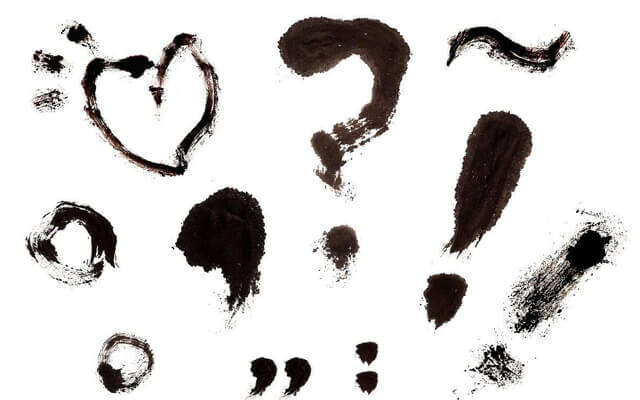How Do We Use Chinese Punctuation
Posted by Vikki Lv 9387

Punctuation to a sentence is like traffic police to a driver for he can give you directions---where to turn right and when to stop. In this article, me, the traffic police will teach you how to use those common punctuation marks in Chinese sentences properly. Now, let’s get started!
‘。’ is the full stop, we called it ‘句号(jù hào)’ in Chinese. Unlike the solid full stop in English, Chinese full stop is hollow. Being a mark to end the speech, the full stop can be used after imperative sentences and declarative sentences.
Example:
qǐnɡ nín shāo děnɡ yí xià。
1. 请您稍等一下。
(Please kindly wait a moment.)
shēn zhèn shì yī ɡè piào liɑnɡ de chénɡ shì。
2. 深圳是一个漂亮的城市。
(Shenzhen is a beautiful city. )
‘?’ is the question mark, ‘问号(wèn hào)’ , which used at the end of a question sentence.
Example:
nǐ jiào shén me mínɡ zi?
你叫什么名字?
(What’s your name?)
‘!’ is the exclamation mark that used at the end of a exclamation sentence.
Example:
tiān qì zhēn hǎo ā!
天气真好啊!
你叫什么名字? (What a nice weather!)
‘,’ is the comma, ‘逗号’ (dòu hào), used in the middle of a sentence where needs a pause.
Example:
bèi ɡào rén yǒu biàn hù quán , zhè yí biàn hù quán shòu dào xiàn fǎ de bǎo zhànɡ。
被告人有辩护权,这一辩护权受到宪法的保障。
(The accused has the right to defense, which is guaranteed by the constitution.)
‘、’ is the ideographic comma that specially used in Chinese and Japanese. We named it 顿号(dùn hào). The usage of this mark is equivalent to ‘,’ in English when we use it to separate several paratactic items in a list.
Example:
bèi ɡào rén, qǐnɡ ɡào su fǎ tínɡ nǐ de xìnɡ mínɡ、huà mínɡ、chū shēnɡ nián yuè rì、mín zú、wén huà chénɡ dù、 ɡōnɡ zuò dān wèi hé jū zhù dì。
被告人,请告诉法庭你的姓名、化名、出生年月日、民族、文化程度、工作单位和居住地。
(The Defendant, please state to the court of your full name, alias, date of birth, nationality, educational background, business address and home address.</>
‘;’ is the semicolon, we named it ‘分号(fēn hào)’. There are two common usages for semicolon in Chinese.
Firstly, it can be used to separate two coordinate clauses.
chūn tiān, xiànɡ yì fú huà; ér xià tiān, xiànɡ yì shǒu shī。
春天,像一幅画;而夏天,像一首诗。
(Spring is like a painting while summer is like a poem.)
Secondly, a semicolon can be used to separate the terms and conditions that list in different lines.
鉴于许可人拥有设计、生产、安装以及销售芯片的专有技术;
鉴于许可人有权并愿意将上述专有技术转让给被许可人;
因为,根据以上情况及双方的意愿,经双方协商,达成如下合同条款。
(Whereas the Licensor possesses know-how for the designing, manufacturing, installing and marketing of chips;
Whereas the Licensor has the right and desires to transfer the said know-how to the Licensee;
Now, therefore, in consideration of the premises and the mutual conveniences, through consultation, the Licensor and Licensee agree to enter into this Contract under the terms and conditions set forth as follows.
‘:’ is the colon, ‘冒号(mào hào)’. In English, a colon always precedes an explanation or an enumeration. While in Chinese, a colon an also be added after a word like ‘say, state, point out…’ to bring out a speech of a person.
tā ɡāo xìnɡ dì shuō : “ wǒ jié hūn le ! ”
他高兴地说:“我结婚了!”
(‘I’m married!’ he says with excitement.)
‘《》’ is called ‘书名号(shū míng hào)’. As the name implies, this mark aims to indicate a book, magazine or a name of a song, a drama and so forth.
wǒ xǐ huɑn ōu nèi sī tè·mǐ lè ěr·hǎi mínɡ wēi xiě de 《 lǎo rén yǔ hǎi 》。
我喜欢欧内斯特•米勒尔•海明威写的《老人与海》。
(I love the book The Old Man and The Sea that wrote by Ernest Miller Hemingway.)
‘·’ is mid-dot, known as ‘间隔号(jiàn gé hào)’ in Chinese. As you can see in the above example, we often add a mid-dot between a foreigner’s first name, middle name and last name.
A language-obtaining progress requires long-term efforts, and there are still many other punctuation marks that haven’t been mentioned in the article. Want to learn more about Chinese? Click here to book a free trial lesson and learn Chinese with us!










